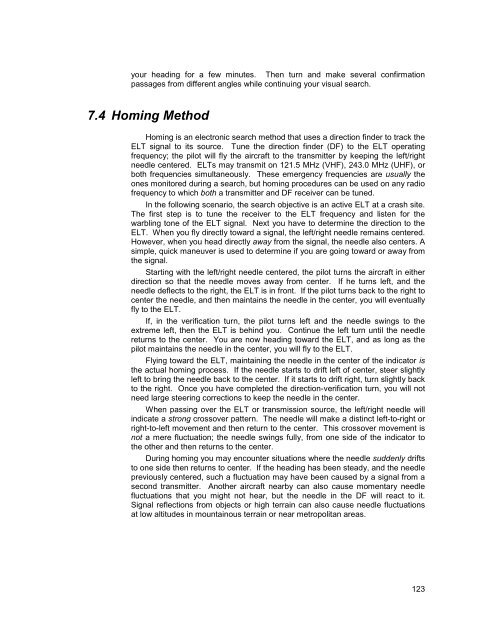MART Vol. II MO/MP - NESA - Civil Air Patrol
MART Vol. II MO/MP - NESA - Civil Air Patrol
MART Vol. II MO/MP - NESA - Civil Air Patrol
Create successful ePaper yourself
Turn your PDF publications into a flip-book with our unique Google optimized e-Paper software.
your heading for a few minutes. Then turn and make several confirmationpassages from different angles while continuing your visual search.7.4 Homing MethodHoming is an electronic search method that uses a direction finder to track theELT signal to its source. Tune the direction finder (DF) to the ELT operatingfrequency; the pilot will fly the aircraft to the transmitter by keeping the left/rightneedle centered. ELTs may transmit on 121.5 MHz (VHF), 243.0 MHz (UHF), orboth frequencies simultaneously. These emergency frequencies are usually theones monitored during a search, but homing procedures can be used on any radiofrequency to which both a transmitter and DF receiver can be tuned.In the following scenario, the search objective is an active ELT at a crash site.The first step is to tune the receiver to the ELT frequency and listen for thewarbling tone of the ELT signal. Next you have to determine the direction to theELT. When you fly directly toward a signal, the left/right needle remains centered.However, when you head directly away from the signal, the needle also centers. Asimple, quick maneuver is used to determine if you are going toward or away fromthe signal.Starting with the left/right needle centered, the pilot turns the aircraft in eitherdirection so that the needle moves away from center. If he turns left, and theneedle deflects to the right, the ELT is in front. If the pilot turns back to the right tocenter the needle, and then maintains the needle in the center, you will eventuallyfly to the ELT.If, in the verification turn, the pilot turns left and the needle swings to theextreme left, then the ELT is behind you. Continue the left turn until the needlereturns to the center. You are now heading toward the ELT, and as long as thepilot maintains the needle in the center, you will fly to the ELT.Flying toward the ELT, maintaining the needle in the center of the indicator isthe actual homing process. If the needle starts to drift left of center, steer slightlyleft to bring the needle back to the center. If it starts to drift right, turn slightly backto the right. Once you have completed the direction-verification turn, you will notneed large steering corrections to keep the needle in the center.When passing over the ELT or transmission source, the left/right needle willindicate a strong crossover pattern. The needle will make a distinct left-to-right orright-to-left movement and then return to the center. This crossover movement isnot a mere fluctuation; the needle swings fully, from one side of the indicator tothe other and then returns to the center.During homing you may encounter situations where the needle suddenly driftsto one side then returns to center. If the heading has been steady, and the needlepreviously centered, such a fluctuation may have been caused by a signal from asecond transmitter. Another aircraft nearby can also cause momentary needlefluctuations that you might not hear, but the needle in the DF will react to it.Signal reflections from objects or high terrain can also cause needle fluctuationsat low altitudes in mountainous terrain or near metropolitan areas.123














